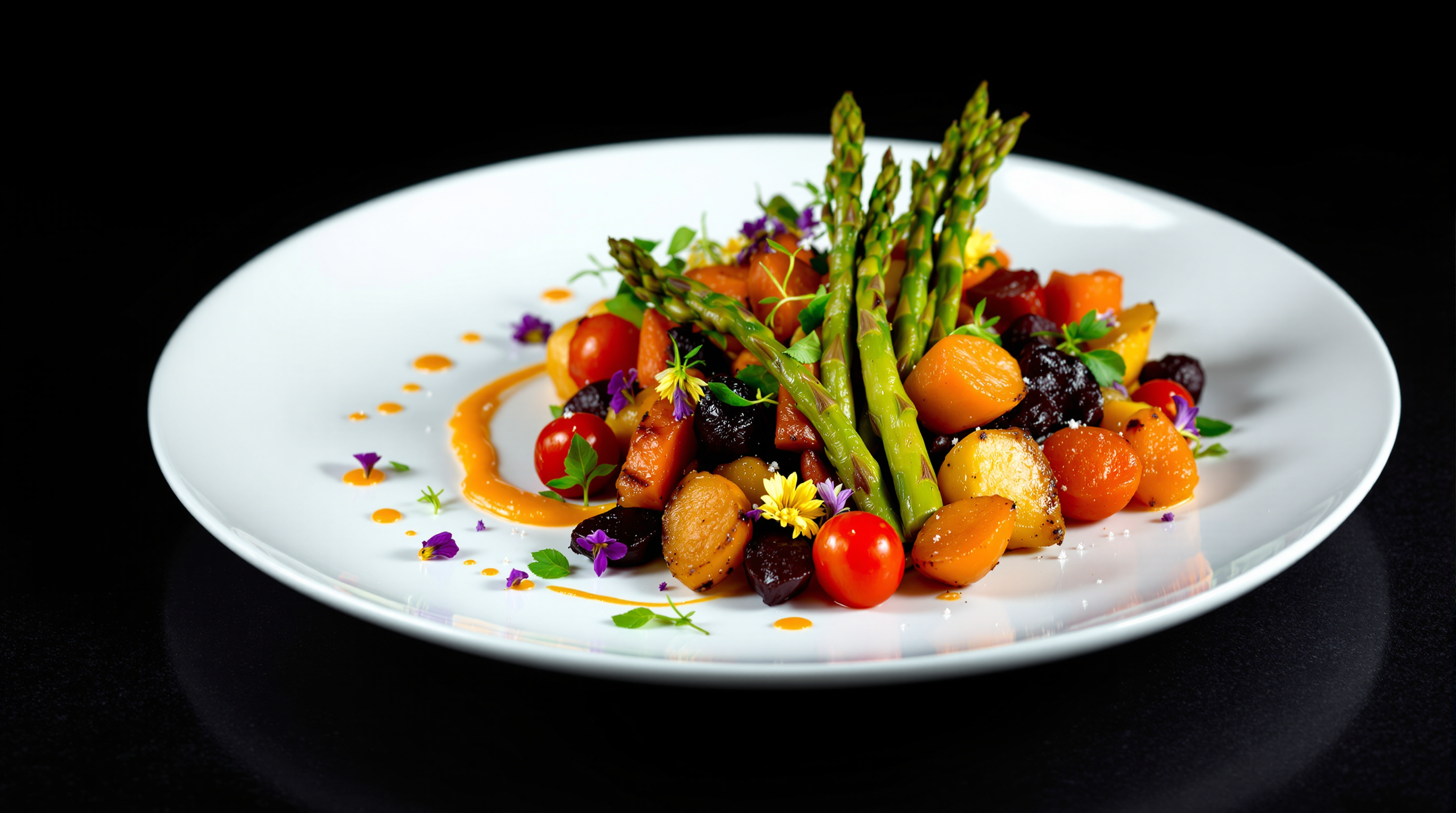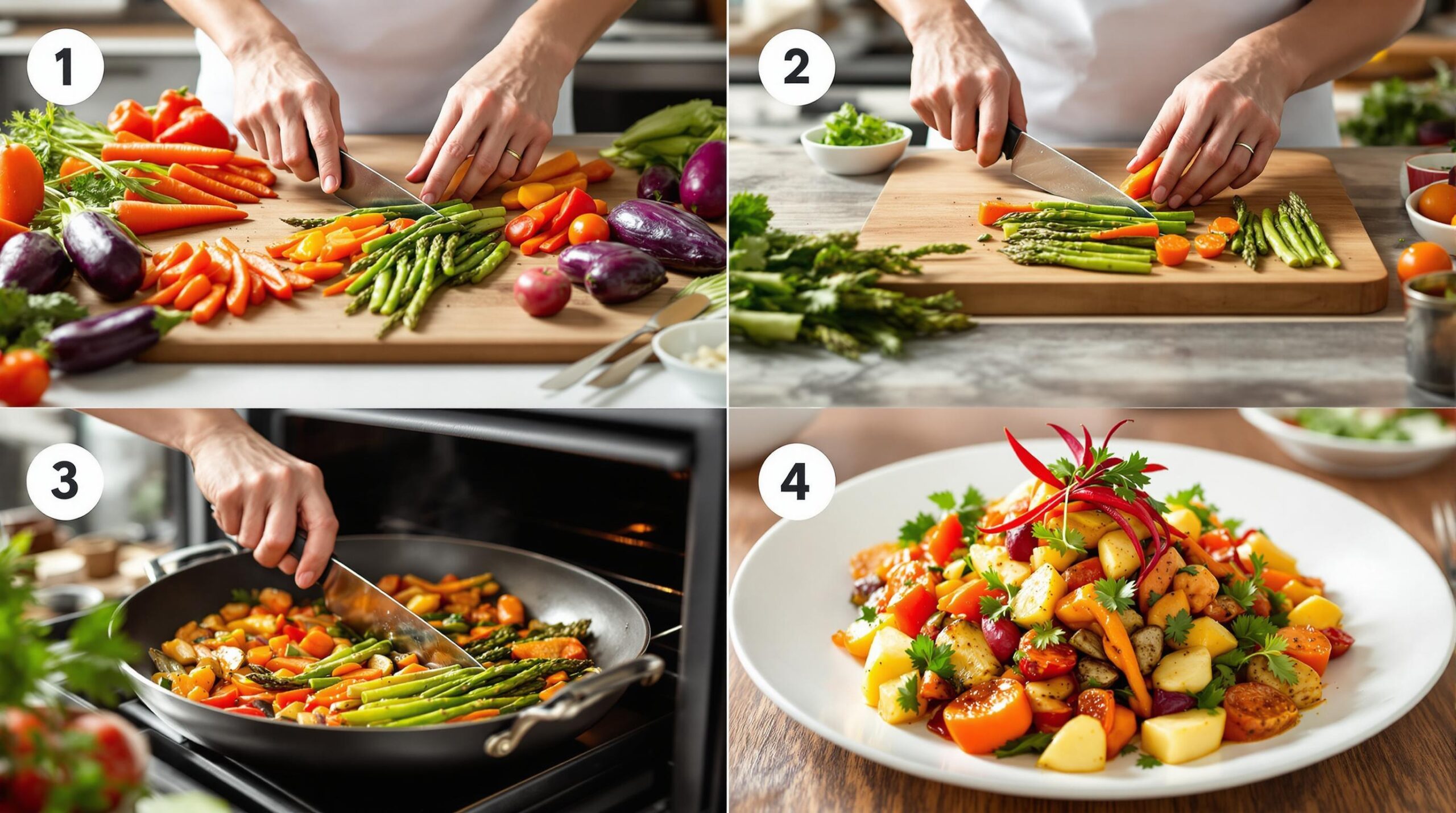Have you ever wondered why restaurant vegetables taste so much better than the ones you make at home? The secret isn’t expensive ingredients or fancy equipment—it’s technique. High-End Vegetable Cuisine is accessible to everyone, and I’m going to show you exactly how to elevate your plant-based cooking with just four fundamental steps.
Overview: The Magic of High-End Vegetable Cuisine
High-End Vegetable Cuisine transforms ordinary produce into extraordinary meals. This approach isn’t about complicated recipes—it’s about understanding how to bring out the best in vegetables through proper selection, preparation, cooking, and presentation.
Time Required: Most techniques take 30-45 minutes once you’re familiar with them Difficulty Level: Beginner to intermediate Why It’s Special: These methods highlight vegetables’ natural flavors rather than masking them

Step 1: Smart Selection – Choose the Right Vegetables
The foundation of High-End Vegetable Cuisine begins before you even start cooking. Selecting the right produce makes all the difference.
Essential Selection Tips:
- Shop seasonally: In-season vegetables have better flavor and nutrition. Spring asparagus, summer tomatoes, fall squash, and winter root vegetables will always outshine their out-of-season counterparts.
- Look for vibrant colors: Bright, rich colors often indicate freshness and higher nutrient content. Deep green kale, bright orange carrots, and purple eggplants should look lively.
- Feel for firmness: Most vegetables should feel firm and heavy for their size. Avoid soft spots or wrinkled skin.
- Consider local and organic options: Locally grown produce is often harvested closer to peak ripeness, while organic vegetables may have more intense flavors.
- Try heirloom varieties: These traditional vegetable varieties often offer unique flavors and textures you won’t find in standard grocery store options.
Substitutions and Variations:
If you can’t find specific vegetables, focus on similar textures and flavors. For example:
- Substitute cauliflower for broccoli
- Use sweet potatoes instead of butternut squash
- Replace spinach with Swiss chard
Step 2: Proper Preparation – Set the Stage for Success
High-End Vegetable Cuisine requires thoughtful preparation before heat ever touches your produce.
Essential Preparation Techniques:
- Uniform cutting: Cut vegetables into similar-sized pieces to ensure even cooking. For example, dice carrots, celery, and onions to the same size for a mirepoix.
- Salt early: Sprinkle salt on cut vegetables 15-20 minutes before cooking to draw out excess moisture and concentrate flavors.
- Dry thoroughly: Pat vegetables completely dry before roasting or sautéing to promote browning instead of steaming.
- Room temperature cooking: Remove vegetables from the refrigerator 20-30 minutes before cooking to help them cook more evenly.
- Blanching and shocking: Briefly boil green vegetables like broccoli or green beans, then immediately plunge into ice water to preserve color and texture.
Preparation Tips:
- Keep vegetable scraps for homemade stock
- Peel only when necessary—many nutrients live in or just under the skin
- Use a sharp knife to prevent crushing delicate vegetables
- Consider a mandoline for ultra-thin, consistent slices
Step 3: Masterful Cooking – Transform Through Heat
The cooking method you choose dramatically affects the final result of your vegetables. High-End Vegetable Cuisine employs specific techniques to develop maximum flavor.
Essential Cooking Methods:
- Roasting (400-425°F): Creates caramelization and concentrates flavors. Perfect for root vegetables, Brussels sprouts, and cauliflower. Tip: Don’t overcrowd the pan—vegetables should have space between them to roast rather than steam.
- Sautéing: Quick cooking in a hot pan with a small amount of fat develops flavor while maintaining texture. Ideal for tender vegetables like zucchini, bell peppers, and leafy greens. Tip: Heat the pan before adding oil, then heat the oil before adding vegetables.
- Braising: Slow-cooking in a small amount of flavorful liquid creates tender vegetables with concentrated flavor. Works beautifully for tougher vegetables like cabbage, leeks, and fennel. Tip: Use vegetable stock, wine, or citrus juice as your braising liquid for added flavor.
- Grilling: Adds smoky flavor and beautiful char marks. Excellent for heartier vegetables like eggplant, portobello mushrooms, and corn. Tip: Lightly oil vegetables before grilling to prevent sticking.
Cooking Tips:
- Don’t be afraid of high heat—it’s essential for caramelization
- Season at multiple stages of cooking, not just at the end
- Use aromatics like garlic, shallots, and herbs to build flavor layers
- Finish with acid (lemon juice, vinegar) to brighten flavors
Step 4: Artistic Presentation – Eat With Your Eyes First
The final step in High-End Vegetable Cuisine is thoughtful presentation. This doesn’t mean complicated plating—it means arranging food in a way that highlights its natural beauty.
Essential Presentation Elements:
- Color contrast: Pair vegetables with complementary colors—orange carrots with green peas, purple beets with yellow corn.
- Texture variety: Combine crispy, crunchy, soft, and creamy elements on one plate.
- Height and layers: Build upward rather than spreading everything flat on the plate.
- Negative space: Leave some empty areas on the plate to make the food stand out.
- Finishing touches: Add microgreens, herb oils, or edible flowers as final accents.
Presentation Tips:
- Use a warm plate to keep food at proper temperature
- Wipe the edges of the plate clean before serving
- Consider the rule of odds—groups of 3 or 5 items look more appealing than even numbers
- Add a sprinkle of flaky sea salt or a drizzle of high-quality olive oil just before serving
Storage and Make-Ahead Tips
High-End Vegetable Cuisine can be prepared in advance with proper storage techniques.
Storage Guidelines:
- Refrigeration: Most cooked vegetables last 3-4 days in airtight containers.
- Freezing: Blanched vegetables freeze well for up to 3 months. Roasted vegetables can become soggy when frozen and thawed.
- Reheating: Avoid microwaving when possible. Instead, reheat vegetables in a hot skillet or 350°F oven to maintain texture.
Make-Ahead Strategies:
- Prep vegetables (wash, chop, blanch) up to 2 days ahead
- Make sauces and dressings up to 5 days in advance
- Partially cook sturdy vegetables, then finish just before serving
- Store components separately and assemble at the last minute
Creative Variations for High-End Vegetable Cuisine
Once you’ve mastered the basics, try these creative variations to expand your High-End Vegetable Cuisine repertoire:
Global Flavor Profiles:
- Mediterranean: Roasted vegetables with olive oil, lemon, garlic, and herbs
- Asian-Inspired: Stir-fried vegetables with ginger, sesame, and soy
- Indian: Vegetables with curry spices, coconut milk, and cilantro
- Mexican: Grilled vegetables with lime, chili, and cumin
Texture Transformations:
- Vegetable chips (thinly sliced and baked until crisp)
- Vegetable purees (smooth and creamy)
- Vegetable noodles (spiralized zucchini, carrots, or beets)
- Stuffed vegetables (hollowed peppers, tomatoes, or squash filled with grains or other vegetables)
Serving Styles:
- Vegetable boards (like charcuterie, but with beautifully arranged vegetables)
- Composed salads (thoughtfully arranged rather than tossed)
- Vegetable terrines (layered and sliced)
- Individual vegetable tarts
Conclusion
High-End Vegetable Cuisine isn’t about complicated recipes or expensive ingredients—it’s about respecting vegetables enough to select, prepare, cook, and present them thoughtfully. By mastering these four simple steps, you’ll transform ordinary produce into extraordinary meals that satisfy both the eye and the palate.
Remember that practice makes perfect. Each time you cook, you’ll develop a better understanding of how vegetables respond to different techniques. Don’t be afraid to experiment and find your own signature style within these guidelines.
The next time you bring home fresh vegetables from the market, think beyond basic steaming or boiling. Apply these High-End Vegetable Cuisine principles, and watch as family and friends marvel at your vegetable mastery!
Frequently Asked Questions
Q: Do I need special equipment to create High-End Vegetable Cuisine? A: No! While tools like a mandoline or good knife make preparation easier, the techniques work with basic kitchen equipment.
Q: Are these methods time-consuming? A: Some techniques take a bit longer than basic cooking, but many (like proper roasting) are hands-off. The results are worth the small extra effort.
Q: What are the health benefits of cooking vegetables this way? A: These methods maximize flavor without relying on excessive fat, salt, or sugar. Many techniques also preserve more nutrients than overcooking.
Q: Can I use frozen vegetables with these techniques? A: Fresh is best for most methods, but frozen vegetables work well for purees, soups, and some braises. Thaw and dry thoroughly before cooking.
Q: How do I get my kids to eat vegetables prepared this way? A: Involve them in the cooking process! Let them choose a vegetable at the market and help prepare it. The beautiful presentation and enhanced flavors often appeal to reluctant vegetable eaters.
Q: Can these techniques work for meal prep? A: Absolutely! Many components can be prepared in advance and combined just before serving. See the storage section for specific tips.

